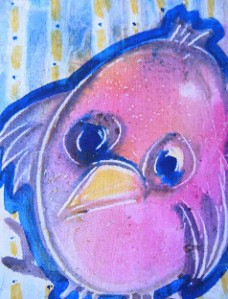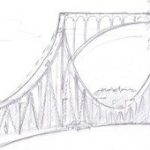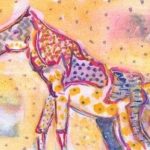The Art of Questioning

They say that art is 99% observation and 1% application but when I say this to my students they usually reply ‘’Ah yeah John, we know that but teach us how to draw and teach us how to paint’’. Then I realize, I really need to explain exactly what is meant by this saying.
The reason for observing is to bring up questions and the reason for questions is to reveal answers. The level of observation dictates the level of enquiry and thus, the level of response. Surface investigation, for example, yields reactionary questions and immediate, predictable answers. On the other hand, a deeper observation yields educated and concerned quieries that give us intelligent, heartfelt, solid solutions. However, both these are the result of brain thinking.
In other words informative, emotional constructs are the outcome of rational observations. At this level of understanding some people guide our world while others try to control it, more manipulate and others still defend it as best they can. With the best of intentions and with the utmost concern, at this level of observation, we find that we are in conflict with ourselves, with one another and with the world at large.
One of the reasons for this is our teaching process. Its single purpose is to prepare us for the work force. From an early age we are encouraged into answering pre-set questions. In short, teaching concerns us with how to singularly engage the brain to regurgitate information and predictible answers.
So, when it comes to asking original questions we don’t know how. Or rather we don’t seem able to quiery in a way that accesses the answers we need. The reason for this is we are taught not how to think, but how to follow. To make matters worse, this process of regurgitation is what we call the thought process and so we know this as thinking. Thus, we have no reason to question it. This has a knock-on affect in the way we approach life. Furthermore, it affects the very heart of our founding establishments.
During my time observing in The Four Courts, whilst preparing works for an art exhibition, I noticed judges, barristers, solicitors and staff who have dedicated their lives to the pursuit of justice and truth. But I can’t help thinking that the odds of finding the truth are stacked against the system when a witness who swears to tell the truth, the whole truth and nothing but the truth may have no idea of his or her own innate abilities. The same can be said of most if not all people in our institutions, organizations and businesses.
Another point strikes me and it concerns the Ten Commandments, the basis of justice in the civilized world. The Ten Truths were transcribed through the innate awareness of Moses. On the other hand, their interpretation in the form of commands comes from an intellectual questioning that gives us physical answers. Thus, there is a complete misinterpretation of their original meaning and intention. Because they document the ground rules of our major institutions, this has a profound affects on every aspect of our lives whether we are religious or not. They form the base of society at a core level and they are faulty.
At a very basic level that our current way of thinking somehow lacks originality. This leads us to inner doubt. From doubt is born fear. This double act is the basis of all conflict for it causes division in people, organizations, institutions, services, departments, governments and countries. As a result, we invite into our world illness, drug addiction, crime, poverty, starvation, pollution, war, injustice and abuse at every level of interaction. Then we logically blame everybody else because our intention is honourable not realizing we are living in ignorance.
The need to quiery and re-invent our value systems and behaviours is abundantly clear if we as a race are to be effectively engaged in the future. If individuals do not alter their thinking, how can we expect organizations, institutions, religions, business, services, departments and governments to change?
The responsibility for making these decisions lies with each person. We need to move from this fear-based existence, from blame and recrimination. It’s necessary to engage beyond the intellect, the heartfelt, the physical and the ready-made regurgitated answers to a place of authentic investigation.
The answers to life’s questions are already there. What we have to do is ask pertinent questions to uncover them. But how do we do that?
We do that by realizing our innate value. And this is the function of art, to help us form that realization. This is the importance of art, and this is its value. This is the reason for art. Art shows us how to explore our imagination, our invention, our intuition, our insight and our instinct so that we are inspired.
When we study the great artists such as Picasso, Dali, Seamus Heaney, Shakespeare and Beethoven and compare them to some of the great minds like Newton, Socrates, Marie Curie or Carl Jung, we realize that they all had one thing in common. They all had that 99% level of observation. How do we know this? We know it because their questions were innate and as a result their answers were knowledgeable, feeling and creative. In other words they were imaginative, instinctive, inventive, intuitive, insightful and inspirational. This is the foundation for thinking and this is the real process of thinking.
Thus, intelligence transcends into knowledge, emotion crosses over into feeling, construction rises to creativity, honesty transforms into truth and blind faith changes into wisdom. At this level of observation and thus, awareness there is no conflict for there are no opposites. There is nothing to control, nothing to manipulate, nothing to force and nothing to defend. In short, there is nobody to doubt and nothing to fear.
When we view our difficulties through the eyes of intelligence and reason we see division. Why? Because we are looking for answers. But when we view the same situations from an innate perspective we see a totally different set of circumstances. We see oneness. Why? The reason is we’re searching for questions.
Let us realize the need to observe 99% of the time, to uncover innate, mindful questions and come up with wise, knowledgeable and truthful answers.
Each man, woman and child is an artist. Everyone without exception has a unique expression that can be brought to the fore. We could bring art into the educational system and the working environment with the intention of encouraging innate connection.
Thus, will our questioning become open, inclusive and imaginative. We can reach new heights. Our inventions can be unique. Intuition and a new insight will inspire us to change the world from separation and division to inclusion and oneness.




